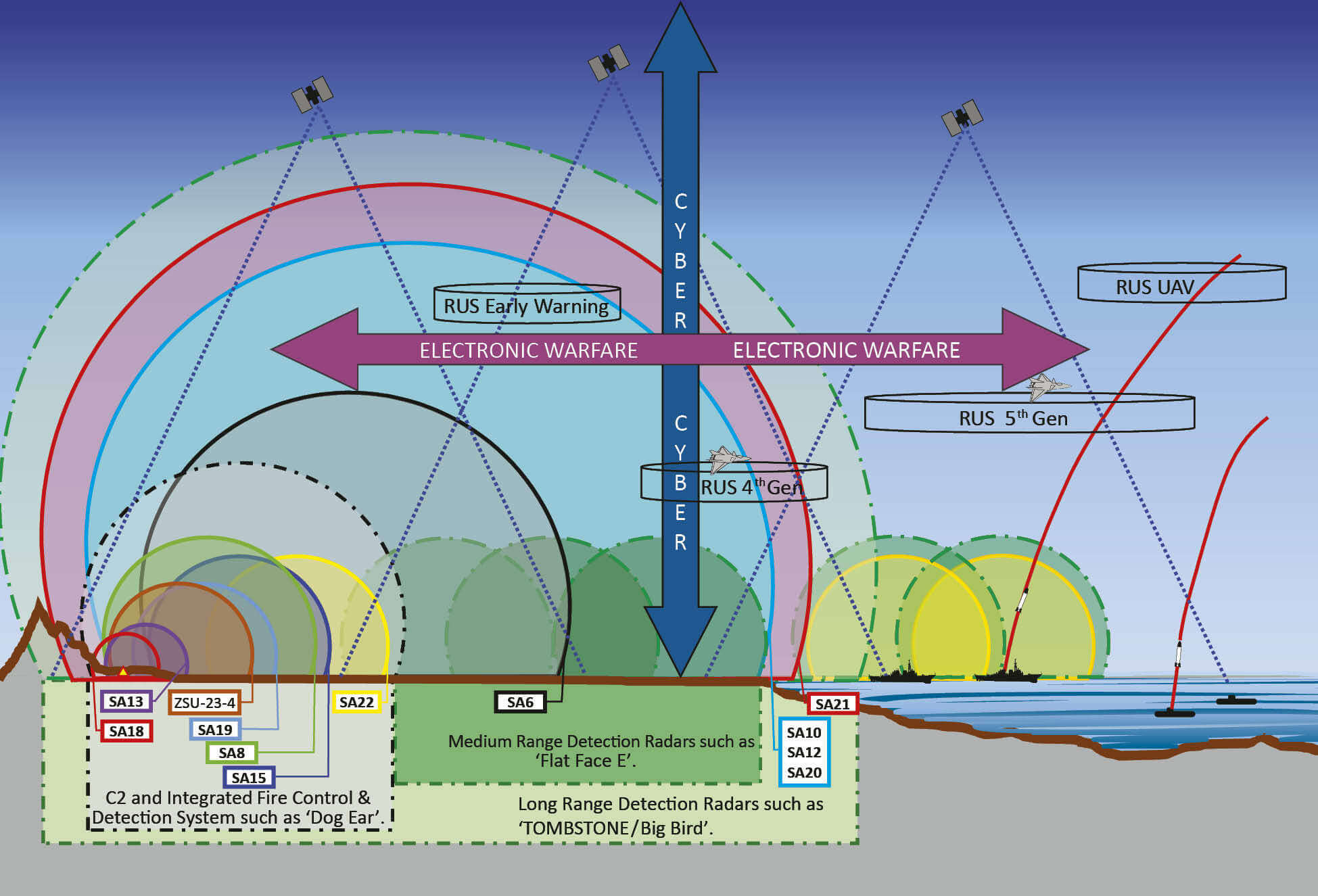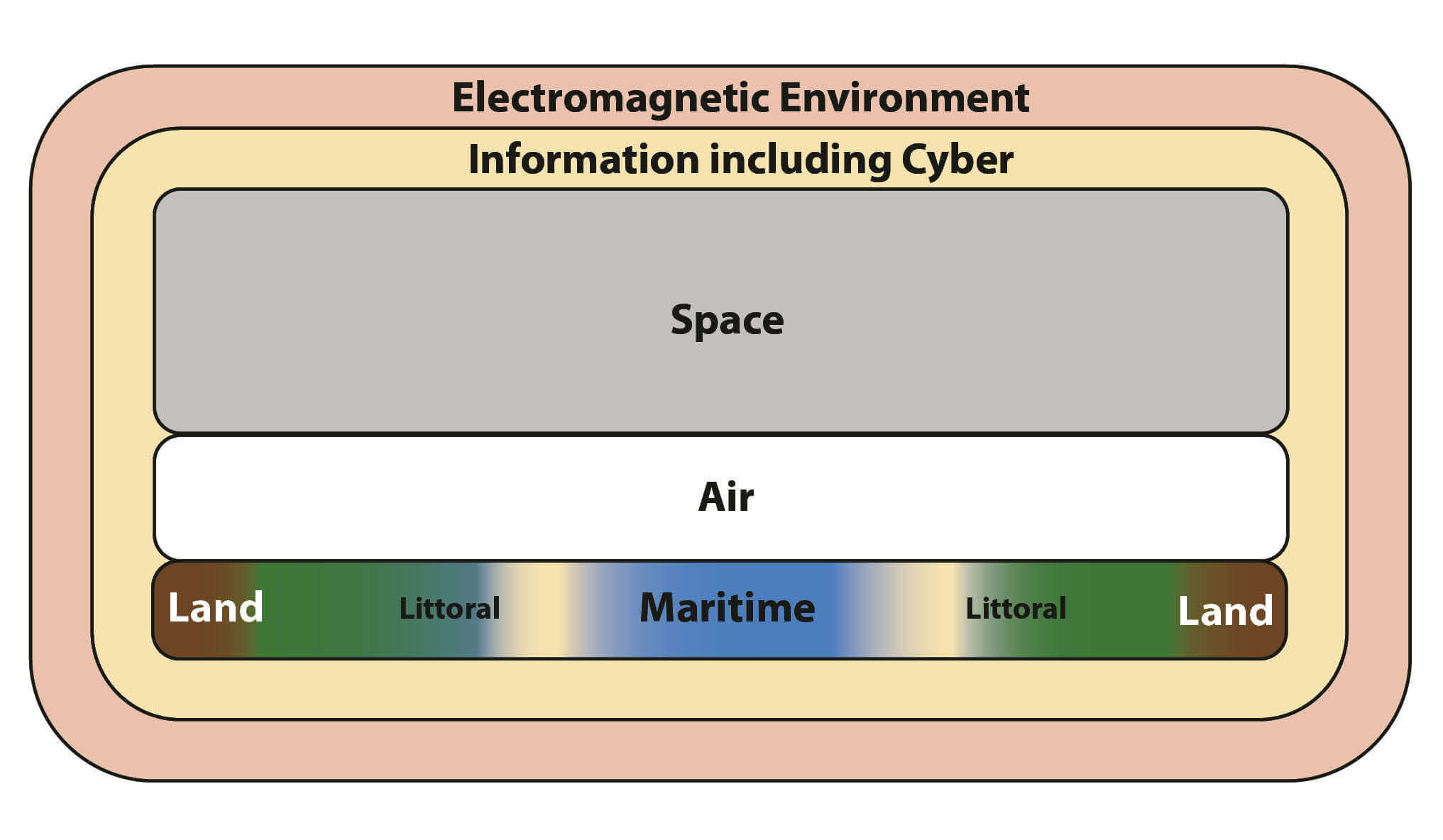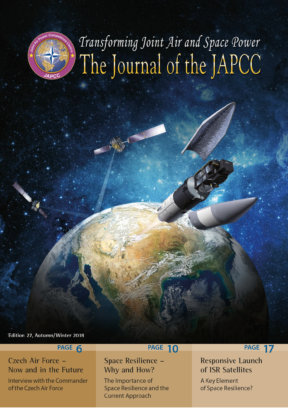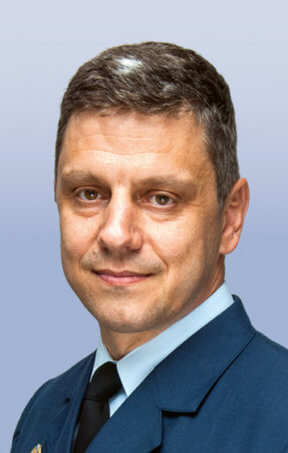Fight for Control of the Skies
The advent of balloons in 1783, and their military employment during the American Civil War (1861–1865) and the Franco-Prussian War (1870–1871),1 highlighted the significance of controlling the skies over a battlefield, and compelled military forces to develop anti-air platform warfare or, in other words, an ‘Air Defence’ (AD) mission. After more than 200 years, the predominant pursuit of AD remains the same; that is, to detect hostile aircraft and deny their freedom of manoeuvre. In contrast with the past, AD is now an integrated element of joint air power, and it is a key component in certain state actors’ overall Anti-Access/Area Denial (A2/AD) strategy.2, 3
In order to allow friendly aircraft to conduct missions and support joint air power operations across the spectrum of warfare – from peacekeeping to high-intensity conflicts – NATO has nurtured developments in the Suppression of Enemy Air Defence (SEAD) mission. However, the newest generation of complex and capable enemy air defence assets threatens to overwhelm NATO’s current SEAD abilities.
Additionally, unlike the front lines of the past 25 years, increasing odds of urbanized conflicts will likely influence the future battlefield environment. The constant increase in enemy AD capabilities and battlefield complexity begs the question: what are some things NATO can do to prepare for emerging SEAD challenges up to, and beyond, the next twenty years?
Urbanized Conflicts
The effects of globalization, technology advancements, scarcity of resources and climate change, the control and access of the physical global commons,4 and sovereign territory pursuits on land are some of the catalysts which may shape the future physical environment.5 In addition, cultural, religious, and nationalistic ideologies are more likely to influence the world than geography.6 All of these factors could provoke increased global redistribution of populations and migration out of rural areas into cities, particularly in the developing world.
Indeed, the global population is expected to increase throughout the foreseeable future,7 with almost all of this growth occurring in the developing world, and largely centred in urban areas. By 2035, urbanization will likely mean that approximately 60% of the global population will live in cities,8 usually near oceans. Beyond 2035, distribution among low-income populations and oligarchs may create a polarized society, where the global demand and supply of basic human needs – such as water and food – could drive conflicts in 30 years’ time.9 Meanwhile, the geopolitical power of the world is apparently shifting from a unipolar to a multipolar paradigm, again towards the south and east of the Alliance, increasing the probability of conflicts and world instability.10

Consequently, NATO forces may be tasked for joint operations in an urbanized geographical area, where conflicts may encompass a variety of missions, from stabilization or humanitarian operations through high-intensity, open combat. For example, the current environment of the Syrian conflict may be an omen of future conditions of the battlefield. That is, an environment in which military forces combat an array of violent state and non-state actors, and operate in, or on the edge of, densely populated cities, or even ‘megacities’. (‘Megacities’ are defined as urban areas that blend into one another and have more than 10 million inhabitants.11) In fact, Syria’s operating environment has exposed some of the difficulties that military forces have conducting various missions, including intelligence, surveillance, target acquisition and reconnaissance (ISTAR), in crowded urban environments.
Because future confrontations will likely take place in an urbanized environment rather than a traditional battlefield, complexity, congestion, degradation, deception, and confusion will likely characterize the future operating environment.
‘Threat’ Environment is Challenging
Over the last 20 years, potential adversaries of the Alliance have studied western military capabilities and have developed robust A2/AD capabilities in response. Examples are abundant, and include threats such as the Russian SA-20 ‘Gargoyle’ and SA-21 ‘Growler’, the Chinese – built HQ-9, and the Dong-Feng 21. These capabilities are tailored to deny the ‘western way of war’ by precluding access to what is arguably the west’s most potent influencer – air power.
Additionally, many state and non-state actors have been creatively employing military and commercial technologies to develop a range of capabilities for symmetric, asymmetric, and hybrid military activities, including AD. The technological trends include the following: anti-stealth technology, hypersonic weapons, cyber warfare, and access to and/or denial of space capabilities, to name a few. For example, Russian long-range surface to air systems now employ radar with anti-stealth technologies such as the ‘NNIIRT 1L119 Nebo SVU/RLM-M Nebo M’ mobile VHF active electronically scanned array (AESA) radar. In the realm of hypersonic, the Russians have an air-launched missile, the ‘Dagger’, which can reach and maintain Mach 10. In addition, China is developing anti-satellite capabilities such as the ‘Dong Neng 2 & 3’ exo-atmospheric vehicles. Primarily, these are direct-ascent missiles designed to ram and destroy satellites.
Also, advances in computing power and digital signal processing are allowing for more capable AD radars. These systems employ advanced techniques to improve acquisition range and target size detection, and possess increased resistance to electronic attack or deception. In addition, new ideas in electromagnetic spectrum management are allowing radar technology to become more passive than active, which significantly complicates locating and targeting such sites. For instance, Russia is developing passive coherent radar designed for stealthy detection of moving aerial, ground and above-water targets in the protected area of important facilities. While passive radar systems are already being employed in both ground and air platforms, they are normally used to locate platforms vice engage them. That being said, passive radars will likely be able to target and guide weapons against air threats soon, significantly complicating the SEAD mission.
Adversaries’ legacy systems of hierarchical data management and links are being replaced with multi-node, high-capacity, efficacy networks, contributing to highly resilient, redundant, and robust Command, Control, Communications, Computers, Intelligence, Surveillance and Reconnaissance (C4ISR) systems. The resiliency of future C4ISR may be augmented by space-based technologies – such as micro-satellite constellations – making an Integrated Air Defence System (IADS) even more effective and agile. In addition, it is quite possible that a nodular system might enable air defence systems to continue to support operations through ‘remote’ operations, even if some parts of the IADS are damaged or destroyed. A current example of this is Russia’s experimentation with multi-node quantum networks. In effect, suppressing or destroying local air defence assets, which are linked into a multi-node network, may not provide effective suppression of the enemy IADS.
‘Remoting’ operations and unmanned technologies may not only increase the survivability of an IADS, but they will likely extend its detection and targeting capabilities by hundreds of miles. For example, the advancements in space technology may extend the ‘remoting’ capabilities of an IADS to altitudes extending into space. The combination of the aforementioned activities may increase the passiveness of an IADS, deny its detection and targeting, and make it resilient to most SEAD activities.
Lastly, over the next twenty years very long-range surface-to-air weapons, with advanced seeker guidance, smart warheads, and new propulsion technologies, may be employed in enemy AD missions. In particular, Surface-to-Air Missile (SAM) engagement zones may be extended up to 500 km. One need look no further than the Russian S-500 next-generation SAM system to see the lethality of future AD. Disturbingly, this particular missile system could enter service as early as 2020. These new long-range weapons’ technologies may contribute to a highly mobile, flexible IADS when combined with increases in computing power and decreasing size of hardware and processors.
In total, the unfortunate paradigm for the Alliance is that while threat systems are becoming more passive (i.e. harder to find and target) they are simultaneously growing in lethality and range. As a consequence, current Alliance suppression capabilities could be rendered ineffective. At first sight, this doesn’t bode well for NATO SEAD of the future. So, what can be done to mitigate this threat?
Suppressing IADS in the Future
During the 2016 NATO-Warsaw Summit, the Heads of State and Government (HOS/G) confirmed the necessity of developing and deploying more effective SEAD capabilities, and acknowledged its increased need due to the evolving A2/AD threat. Even though Alliance leaders traditionally have considered SEAD to be a ‘kinetic’ air power activity, looking ahead it is quite likely that technological advancements will allow for a greater range of options.
As described, the Alliance expects future IADS to be complex, largely passive, and low observable, yet likely nestled in/throughout urban areas. Therefore, in addition to ‘traditional’ methods of SEAD, planners should consider new weapons and methods, both lethal and non-lethal, to suppress air defences of the future. NATO SEAD forces should consider integrating solutions that include the following:

High Precision Hypersonic and Hypervelocity Weapons – Due to the high mobility and extreme speeds of modern SAMs, the ‘windows’ to engage them and their enablers have grown increasingly small over the past years, necessitating an exponential improvement in reaction time from SEAD forces. Therefore, nations and industry should develop weapons used in support of SEAD missions, such as Anti-Radiation Missiles (ARMs), that include specifications for high agility, high energy and high terminal manoeuvrability in order to reach adversary SAM systems before the ‘window’ closes.
Electromagnetic Spectrum (EMS) Energy Footprint Effects Management – The low observability and passiveness of threat systems will likely increase the volume of targeting uncertainty, so it may become problematic to target specific IADS components. However, it may be possible to control area coverage of an electromagnetic spectrum. Non-lethal weapons, such as a tailored Directed Energy (DE) or Electromagnetic Pulse (EMP) weapon, could effectively suppress low observable and passive air defence systems. For instance, precise control in the effects of an EMP weapon may suppress various IADS components over many square miles, which may deny its collective targeting of friendly forces.
Integration of EMS – Particularly in urban environments, there is a great need to integrate Alliance EMS efforts, especially if employing non-lethal effects in the future battlefield. Thus, electromagnetic spectrum activities should be coordinated and employed from both physical (land, air, maritime/littoral, and space) and non-physical (information, cyber, and electromagnetic) operating domains. To put it simply, if electromagnetic spectrum activities are integrated with every operating domain, it will ensure increased interoperability and effectiveness of IADS suppression.
Resilient & Redundant ISR Operations – In the future, unmanned technologies will increasingly provide passively collected, reliable ISR information in support of IADS suppression. Technology is already allowing linking of unmanned platforms with artificial intelligence and robotics. Biomimetic flocks of ‘birds’, schools of ‘fish’, and herds of ‘rabbits’ – which may behave as natural ISR swarms – consequently increase the probability of detecting low observable and passive enemy IADS elements. Add to this robust – and growing – constellations of satellites (CONoSAT) orbits around the earth in support of surveillance and reconnaissance activities, and the resultant coverage may leave little unable to be detected or targeted on the earth’s surface, in the air, and in space.
Summary
The characteristics of the future battle will necessitate SEAD advancements in multiple, non-traditional domains, such as electromagnetic, space, and cyber, rather than just traditional ones. Nevertheless, ‘kinetic’ SEAD power will still be required, albeit with much improved capabilities, especially in regards to range and speed.
In much the same way that air defence systems have evolved to deny access to one of NATO’s greatest strengths, the Alliance’s SEAD capabilities must also evolve at the ‘speed and flexibility of technology’ if we hope to maintain the advantage that NATO air power brings to the fight. In a high-intensity, urbanized conflict, which may well be the worst-case scenario for any SEAD operation, the ability to combine lethal, non-lethal, and/or cognitive effects12 might be the saving grace that ultimately enables success.









